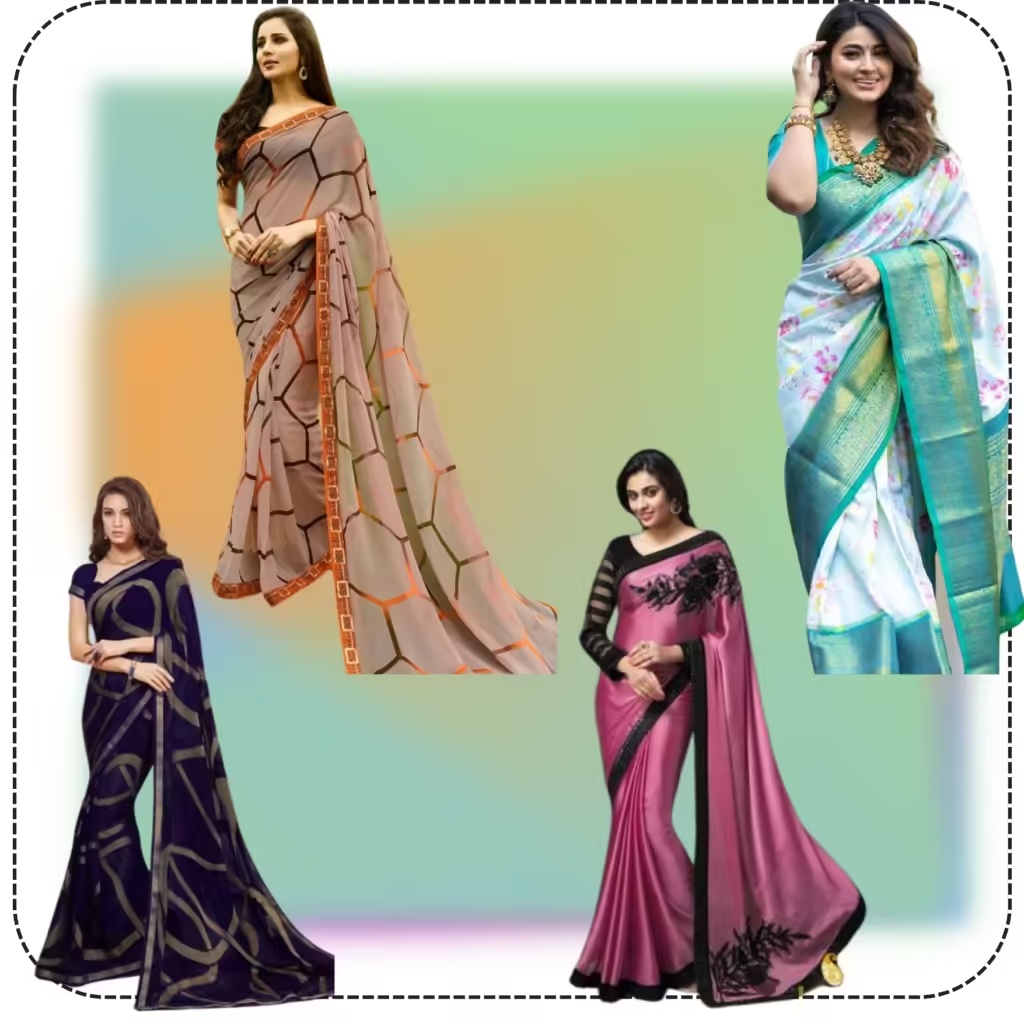The Eternal Charm of Silk Sarees
An Insight into Tradition, Beauty, and Craft
Silk sarees have earned appreciation for their elegance, soft touch, and exquisite works of art, and that’s the reason why they have remained a true fashion statement throughout the ages in India. Worn at weddings, festivals, or even at corporate events, a silk saree is not merely an item of clothing; it is a piece of artistry, one that embodies decades of cultural legacy, and showcases the extensive textiles of India. In this blog post, we will delve into the art and culture of silk sarees, their selection, and many more silk saree related queries that help you soothe your understanding of why such pieces have always been in vogue.
The Deep Chronicles and Historical Significance of Silk Sarees

History of silk sarees dates back to more than two thousand years and it is as colorful as the fabric itself. It was the Chinese who first introduced silk weaving in India, though, it was ……. , that over time, became assimilated into Indian culture. This was especially the case in areas such as Varanasi, Kanchipuram, and Mysore where Bengal has seen more of the art and less of the industry, the silk weaving skills were passed ……….
The period of the Mauryas and later on of the Gupta Empire silk began to lace the borders of the saris, adorned the fabrics of the nobles and due to prosperous trade with the Silk Road Indian craftsmen started learning new methods od carrying out embellishment. Even silk in contemporary usage is considered associated with monarchs and extreme wealth and embellishment. Traditionally in the Indian culture, if one wore a silk saree women knew that she was very privileged and came from a wealthy family. As of today also, silk sarees are predominant on important events like marriages, religious events, and festivals, which strengthens their ethnical relevance
Categories of Silk Sarees
Silk sarees are available in different classifications, each variation having its distinct patterns, methods of weaving, and geographical importance. Here are some of the famous types:
Kanchipuram Silk Saree
Of all the silk sarees present in India, Kanchipuram silk sarees made in Kanchipuram town located in Tamil Nadu are probably the best known. These sarees have a rich clash of vivid colors combined with intricate thick weaved gold or silver threads and are purely made from mulberry silk. It is also well known that this kind of clothing has an exceptionally good structure and texture and does not lose its luster, unlike other fabrics over time. Designs on the borders are usually taken from the inspiration of’s temples and also from the natural surroundings that include pictures of peacocks, parrots and flowers.
Banarasi Silk Saree
Banarasi sarees are designed for women of Varanasi (Banaras) with all the sense of opulence and magnificence they spread around. The art of making Banarasi silks is embroiled in specialized processes such as brocade, gold and silver kundan, and sheer grass works. Each design is done in pure silk with very high quality gold and silver threads in the making which have complicated floral and paisley designs in its interiors. Banarasi sarees are imported and almost packaged in trousseaus of brides in some states of Northern India, especially during weddings.
Mysore Silk Saree
Karnataka’s Mysore district is where these silk saris with intricate designs were created. Mysore silk needless to say uses the best quality of spun mulberry silk. Glorious colors and soft texture are the main characteristics of these sarees which are usually very plain. Instruction of putting layers of gold zari on the borders of Mysore silk sarees is common and the saree fabric is light in weight thus suitable for both office and day to day wear.
Tussar Silk Sarees
The sumptuous and cosmopolitan Tussar silk or Kosa silk is famed for its organic feel and warm colors. This silk is exclusively sourced from karela named as Tussar or Wild Mulberry. Tussar silk sarees tend to be lighter than other varieties of silk sarees. They are available in many styles – those that are simply draped, to those that are heavily embroidered. These sarees are widely in demand for casual as well as semi-casual functions.
Assam Silk Sarees
The Assamese silks are associated with the two thypes of silk that is traditionally bred in Assam namely Muga silk and Eri silk. The muga is of golden colour in most cases and resists the temptations of several contorted and daring designs. Motifs and embroideries characterizing the Assam silk sarees are minute and thin lattices and their use integrate regional aspects such as ethnic tribal motifs or flowers into the designs.
Chanderi Silk Sari
Known for its sheer quality and feathery texture, Chanderi silk is a native fabric to the state of Madhya Pradesh. These sarees have a lightweight and shiny fabric and most of the time they incorporate intricate designs created with fabrics made of gold or silver threads. Patterns found in Chanderi silk sarees may also be based on natural images, shapes that are geometrical, and emblems of royalty.
How to Pick the Best silk saris Choosing the right silk saree takes into consideration the occasion as well as personal preferences such as style and flavor. The following are some of the suggestions that can guide you in making the ideal selection:
Think about the Purpose
For a wedding or festive occasion, choose brides with lavish, heavy silk saris such as Kanchipuram or Banarasi sarees. These sarees are suitable to create a dramatic look. However, for casual or day-to-day purposes, Mysore silk or Tussar silk saris are ideal as they are lightweight, easy to wear and easy to handle draping.
Select the Appropriate Color
There are silk sarees of every possible color. For a formal event, it is commonplace to see traditional colors such as red, gold, green, and dignified blue. However, contemporary silk sarees also come pastel colored and light in shades which are actually very reasonable for breakfast or brunch parties for offices or even resort wear.
Texture and Material
The weight of the silk is yet another aspect that cannot be ignored. Kanchipuram and Banarasi sreekhandhs are generally heavier and more regal in appearance, while Mysore srawas and tussar srawas are light and airy, making them more acceptable in hotter climates and for prolonged use.
Zari and Embroidery Work
Zari work which involves weaving with threads of silver and gold is a very vital aspect among the silk sarees in the market today. Zari work trends higher in pricing the more elaborate it is on the saree. Look for a saree which does not have an elaborate design with imprinted or stitched zari work if you want something simple.
Wear Ability and Tailoring
Comfort and draping skills are important because silk sarees are usually heavy and certain silks, especially require skill to drape on the body. It is also important that one considers the type of saree that they are capable of wearing comfortably rather than struggling with draping.
Care Tips for
Silk sarees are beautiful however they require a lot of care in order to retain their beauty. The following are a few care tips to help maintain their beauty.
Professional cleaning only: Since this is a delicate material, washing the silk sarees at home should not be done.
Keeping them: A cotton or muslin bag should be used to keep the silk sarees in so that dust does not accumulate on them and so that they do not get damaged by light.
Do not expose to sunlight: Silk if kept in sunlight or if sunlight directly strikes the fabric for a long time, can lose its shine and therefore all silk material should be kept in a dry and cool area.
Pressing: Pressing silk sarees should be done at low temperatures and preferably a cloth should be placed on top of the saree to protect it from the iron burns and marks.
The distinctiveness of silk sarees lies in their luxurious texture, intricate patterns and designs, and the craftsmanship that goes into weaving them. The materials used in making the silk sarees are organic, light and allows for air circulation, thus can be worn for several different events. Also, ornate embroidery and handwork embellishing silk sarees evoke a very traditional and graceful style.
The simplest method to ascertain whether a saree is fabricated from unadulterated silk or not is to take a small bit of the cloth and set it on fire. Much like hair, pure silk takes a while to burn and gives off a putrid smell but when it burns out, it leaves behind a dark burnt ash. Whereas, imitation silk also known as polyester will not burn but melt and there is a sweet smell burning plastic during the process.
Although silk sarees are usually worn for more formal and celebratory events, lighter varieties like Mysore silk or Tussar silk can be worn every day without any discomfort. These sarees are light, easy to wear, and have good air circulation making them appropriate for everyday consumption.
Absolutely, silk sarees can be summer wear as well, particularly the lighter variations like the Tussar and Mysore silks. Such sarees are breathable by nature and thus you can wear them even when the weather is warm. Bright summer months require that one wears sarees that are slightly less adorned and have thinner layers.
If well taken care of, a silk saree might be around for several decades, though its appearance at times, gets better with time. Some wear and tear maintenance such as dry-cleaning and keeping the saree away in a certain way will ensure that the texture and shininess of the fabric remains.
Conclusion
For many centuries, silk sarees have been a part of Indian Fashion and culture, due to its always in fashion nature, and exquisite craftsmanship with love.Whether you’re attending a wedding, a cultural event, or simply want to feel elegant and poised, a silk saree is a perfect choice. From Kanchipuram and Banarasi to Tussar and Mysore silk, the variety of designs, colors, and textures available ensures that there is a silk saree for every occasion and personal style. By understanding the different types, selecting the right saree for the occasion, and taking care of it properly, you can enjoy the beauty of silk for years to come.


Recent Comments